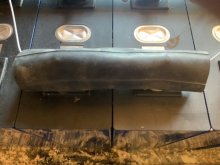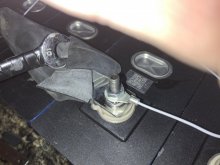Johncfii
Solar Enthusiast
- Joined
- Nov 24, 2020
- Messages
- 265
I thought I would offer up my simple practice for insulating bus bars and battery terminals that I haven’t seen mentioned before.
I use a small-diameter bicycle inner tube, cut into lengths a bit longer than the length of the bus bar. i cut back each end of The “under-side” of the rubber tube to a bit less than the distance between terminals. Or, somewhat more elaborate, cut a hole in each end of the “underside“ of the rubber tube, a bit larger than the battery terminal, so that the hole in each end lines up with the battery terminal. (I’ve done it both ways.) Slip the rubber over the bus bar before attaching to the terminals. Each end of the rubber tube is then a “flap“ that covers the terminals, and that can be stretched or folded back for wrench access to the terminal screws or studs. I’ve been using this for almost 10 years with my large AGM batteries, and it works just fine with my new LiFePO4 strings.
With the massive amount of energy stored in these batteries, I decided it wise to minimize the risk of any metal object accidentally brushing/bridging any connections. Even with a cover, or enclosure lid for protection, these insulators are a suitable precaution against an inadvertent short whIle doing battery maintenance. If you have an old inner tube that was replaced because of a leak, these insulators cost nothing.
I would post a photo, but my job has me away from home for an extended period.
I use a small-diameter bicycle inner tube, cut into lengths a bit longer than the length of the bus bar. i cut back each end of The “under-side” of the rubber tube to a bit less than the distance between terminals. Or, somewhat more elaborate, cut a hole in each end of the “underside“ of the rubber tube, a bit larger than the battery terminal, so that the hole in each end lines up with the battery terminal. (I’ve done it both ways.) Slip the rubber over the bus bar before attaching to the terminals. Each end of the rubber tube is then a “flap“ that covers the terminals, and that can be stretched or folded back for wrench access to the terminal screws or studs. I’ve been using this for almost 10 years with my large AGM batteries, and it works just fine with my new LiFePO4 strings.
With the massive amount of energy stored in these batteries, I decided it wise to minimize the risk of any metal object accidentally brushing/bridging any connections. Even with a cover, or enclosure lid for protection, these insulators are a suitable precaution against an inadvertent short whIle doing battery maintenance. If you have an old inner tube that was replaced because of a leak, these insulators cost nothing.
I would post a photo, but my job has me away from home for an extended period.
Last edited:




